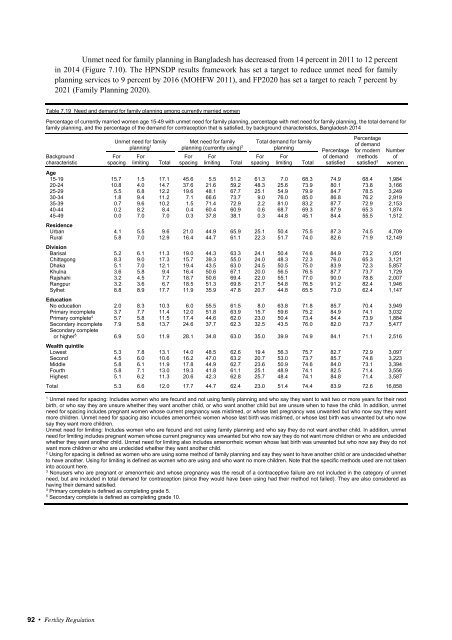Bangladesh 2014
8ln3LMTjp
8ln3LMTjp
Create successful ePaper yourself
Turn your PDF publications into a flip-book with our unique Google optimized e-Paper software.
Unmet need for family planning in <strong>Bangladesh</strong> has decreased from 14 percent in 2011 to 12 percent<br />
in <strong>2014</strong> (Figure 7.10). The HPNSDP results framework has set a target to reduce unmet need for family<br />
planning services to 9 percent by 2016 (MOHFW 2011), and FP2020 has set a target to reach 7 percent by<br />
2021 (Family Planning 2020).<br />
Table 7.19 Need and demand for family planning among currently married women<br />
Percentage of currently married women age 15-49 with unmet need for family planning, percentage with met need for family planning, the total demand for<br />
family planning, and the percentage of the demand for contraception that is satisfied, by background characteristics, <strong>Bangladesh</strong> <strong>2014</strong><br />
Background<br />
characteristic<br />
Unmet need for family<br />
planning 1<br />
For<br />
spacing<br />
For<br />
limiting<br />
Total<br />
Met need for family<br />
planning (currently using) 2<br />
For<br />
spacing<br />
For<br />
limiting<br />
Total<br />
Total demand for family<br />
planning<br />
For<br />
spacing<br />
For<br />
limiting<br />
Total<br />
Percentage<br />
of demand<br />
satisfied<br />
Percentage<br />
of demand<br />
for modern<br />
methods<br />
satisfied 3<br />
Number<br />
of<br />
women<br />
Age<br />
15-19 15.7 1.5 17.1 45.6 5.5 51.2 61.3 7.0 68.3 74.9 68.4 1,984<br />
20-24 10.8 4.0 14.7 37.6 21.6 59.2 48.3 25.6 73.9 80.1 73.8 3,166<br />
25-29 5.5 6.8 12.2 19.6 48.1 67.7 25.1 54.9 79.9 84.7 78.5 3,249<br />
30-34 1.8 9.4 11.2 7.1 66.6 73.7 9.0 76.0 85.0 86.8 76.2 2,919<br />
35-39 0.7 9.6 10.2 1.5 71.4 72.9 2.2 81.0 83.2 87.7 72.9 2,153<br />
40-44 0.2 8.2 8.4 0.4 60.4 60.9 0.6 68.7 69.3 87.9 65.3 1,874<br />
45-49 0.0 7.0 7.0 0.3 37.8 38.1 0.3 44.8 45.1 84.4 55.5 1,512<br />
Residence<br />
Urban 4.1 5.5 9.6 21.0 44.9 65.9 25.1 50.4 75.5 87.3 74.5 4,709<br />
Rural 5.8 7.0 12.9 16.4 44.7 61.1 22.3 51.7 74.0 82.6 71.9 12,149<br />
Division<br />
Barisal 5.2 6.1 11.3 19.0 44.3 63.3 24.1 50.4 74.6 84.9 73.2 1,051<br />
Chittagong 8.3 9.0 17.3 15.7 39.3 55.0 24.0 48.3 72.3 76.0 65.3 3,121<br />
Dhaka 5.1 7.0 12.1 19.4 43.5 63.0 24.5 50.5 75.0 83.9 72.3 5,857<br />
Khulna 3.6 5.8 9.4 16.4 50.6 67.1 20.0 56.5 76.5 87.7 73.7 1,729<br />
Rajshahi 3.2 4.5 7.7 18.7 50.6 69.4 22.0 55.1 77.0 90.0 78.8 2,007<br />
Rangpur 3.2 3.6 6.7 18.5 51.3 69.8 21.7 54.8 76.5 91.2 82.4 1,946<br />
Sylhet 8.8 8.9 17.7 11.9 35.9 47.8 20.7 44.8 65.5 73.0 62.4 1,147<br />
Education<br />
No education 2.0 8.3 10.3 6.0 55.5 61.5 8.0 63.8 71.8 85.7 70.4 3,949<br />
Primary incomplete 3.7 7.7 11.4 12.0 51.8 63.9 15.7 59.6 75.2 84.9 74.1 3,032<br />
Primary complete 4 5.7 5.8 11.5 17.4 44.6 62.0 23.0 50.4 73.4 84.4 73.9 1,884<br />
Secondary incomplete 7.9 5.8 13.7 24.6 37.7 62.3 32.5 43.5 76.0 82.0 73.7 5,477<br />
Secondary complete<br />
or higher 5 6.9 5.0 11.9 28.1 34.8 63.0 35.0 39.9 74.9 84.1 71.1 2,516<br />
Wealth quintile<br />
Lowest 5.3 7.8 13.1 14.0 48.5 62.6 19.4 56.3 75.7 82.7 72.9 3,097<br />
Second 4.5 6.0 10.6 16.2 47.0 63.2 20.7 53.0 73.7 85.7 74.8 3,223<br />
Middle 5.8 6.1 11.9 17.8 44.9 62.7 23.6 50.9 74.6 84.0 73.1 3,394<br />
Fourth 5.8 7.1 13.0 19.3 41.8 61.1 25.1 48.9 74.1 82.5 71.4 3,556<br />
Highest 5.1 6.2 11.3 20.6 42.3 62.8 25.7 48.4 74.1 84.8 71.4 3,587<br />
Total 5.3 6.6 12.0 17.7 44.7 62.4 23.0 51.4 74.4 83.9 72.6 16,858<br />
1<br />
Unmet need for spacing: Includes women who are fecund and not using family planning and who say they want to wait two or more years for their next<br />
birth, or who say they are unsure whether they want another child, or who want another child but are unsure when to have the child. In addition, unmet<br />
need for spacing includes pregnant women whose current pregnancy was mistimed, or whose last pregnancy was unwanted but who now say they want<br />
more children. Unmet need for spacing also includes amenorrheic women whose last birth was mistimed, or whose last birth was unwanted but who now<br />
say they want more children.<br />
Unmet need for limiting: Includes women who are fecund and not using family planning and who say they do not want another child. In addition, unmet<br />
need for limiting includes pregnant women whose current pregnancy was unwanted but who now say they do not want more children or who are undecided<br />
whether they want another child. Unmet need for limiting also includes amenorrheic women whose last birth was unwanted but who now say they do not<br />
want more children or who are undecided whether they want another child.<br />
2<br />
Using for spacing is defined as women who are using some method of family planning and say they want to have another child or are undecided whether<br />
to have another. Using for limiting is defined as women who are using and who want no more children. Note that the specific methods used are not taken<br />
into account here.<br />
3<br />
Nonusers who are pregnant or amenorrheic and whose pregnancy was the result of a contraceptive failure are not included in the category of unmet<br />
need, but are included in total demand for contraception (since they would have been using had their method not failed). They are also considered as<br />
having their demand satisfied.<br />
4<br />
Primary complete is defined as completing grade 5.<br />
5<br />
Secondary complete is defined as completing grade 10.<br />
92 • Fertility Regulation


